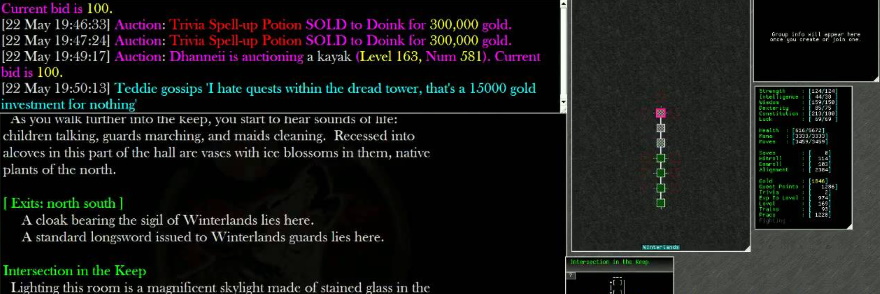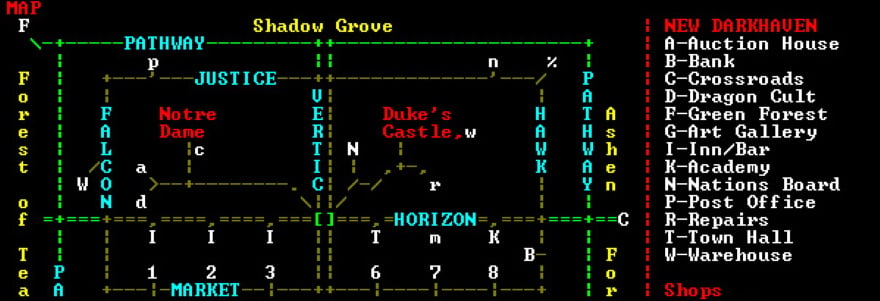
You know that sinking feeling when you get into something that’s way, waaaay over your head and you have no choice but to swim furiously or drown? That’s exactly how I felt when I dug into the history of Multi-User Dungeons, more commonly known as MUDs.
Along with Dungeons & Dragons and Bulletin Board Systems, the MUD was one of the key predecessors to the MMORPG as we know it today. It was a piece of vital gaming history that helped to shape the genre — and an overwhelming topic that spans decades, sub-genres, and countless games.
This week we’ll take a look at the brief history of the MUD and its many spin-offs. So hold your breath and jump on in with me!
The pre-history: Adventure games
As home computers became more and more prevalent in the mid- to late-1970s, creative programmers struggled with the limitations of storage and graphical capabilities that this medium possessed. Fortunately, text-based games proved a simple solution to both limitations, which spurred the rise of adventure games.
While today’s rare adventure game is generally a puzzle-based interactive movie, the first adventure games were fully text, created to harbor both puzzles and combat in the vein of classic D&D sessions. For the better part of a decade, gamers ate up classic titles like Adventure, Zork, Planetfall, The Hobbit and The Hitchhiker’s Guide to the Galaxy and demanded more. In fact, one of my earliest memories as a gamer is watching an older kid playing Adventure while we were at his house for a party. We were absolutely entranced with this virtual world and kept pestering him to keep exploring so that we could find out what else was out there.
With something as simple as text descriptions and a simple parser, players could enter these virtual worlds and go on amazing journeys. The only problem is that they did it completely alone and could not share that experience with others.
The launch of MUD1
Having fun by yourself is all well and good, but these innovative gamers wanted something more: to have their friends join in on the fun. It didn’t take that long for this to happen, either. From 1978 to 1980, two college kids — Roy Trubshaw and Richard Bartle — cobbled together the very first MUD, named MUD1 (but sometimes dubbed British Legends), and threw it online.
In MUD1, players could enter into a virtual fantasy world and interact via a text parser (think simple language commands like “get sword” or “go north”), much like an adventure game. Unlike adventure games, however, MUD1 allowed gamers using the same program to communicate and interact with each other over ARPANET, the precursor to the internet.
Right from the start, MUD1 had the template for many MMO staples that we take for granted today, such as levels. Bartle once said, “Design decisions Roy and I made for MUD1 have been passed down unaltered through generations of virtual worlds, often without designers even realizing that they had a choice in the matter.”
In his opinion, Bartle thinks text-based MMOs contained advantages that graphical MMOs have yet to replicate. “Text is more expressive than graphics. It’s also more descriptive — there are no smells in EverQuest,” he said. “With text, I can talk to the mind. With graphics, I can only talk to the senses.”
Unfortunately, MUDs never went quite as widespread as hoped in the ’80s due to numerous technical and logistical obstacles. Still, the seeds of the genre were planted, and hardcore fans kept the dream alive.
Birth of an industry
It’s here that our history lesson fractures and splinters under the weight of dozens of other designers and programmers who picked up on this idea of shared virtual worlds and ran with it. As Bartle was finishing MUD2 in the mid-’80s, sites such as CompuServe and GEnie started hosting several online games (typically charging by the hour) while programmers created their own text-based codebases such as TinyMUD, TinyMUCK, MOO, AberMUD, and LPMUD.
In 1984, one enterprising individual created both a MUD called Aradath and a commercial gaming site called Gamers World on which to play it. The man? Future Dark Age of Camelot and Camelot Unchained creator Mark Jacobs.
With the ’90s came the rise of the internet, faster modems, and a widespread acceptance of MUDs and their ilk in online gaming culture. Before Ultima Online or Meridian 59 came to be, players were already traipsing around in virtual worlds, killing mobs for loot, and getting ready to complain about World of Warcraft.
These multiplayer RPGs covered the gamut of popular franchises (such as Lord of the Rings) to political intrigue to interstellar exploration to, erm, adult content. Some were huge, others tiny. Some required payments, others were free. Some lacked stats, others reveled in them. And some focused on puzzles, while others were obsessed with worldwide domination.
Attack of the clever acronyms
Not every MUD or MUD-alike existed to be a D&D-style game; several were used as virtual roleplay environments (think Second Life) or for educational purposes. And just like we see in today’s increasingly diverse MMO market, the descendants of MUD showed a huge amount of variety and focus, which makes exact definitions difficult.
For example, you had the MOO (MUD, object oriented), MUSHes (multi-user shared hallucination), the MUCK (multi-user chat kingdom), and the MUSE (multi-user simulated environment). Each was utilized in different ways, but most all of them were adopted by the RPG community for gaming and roleplaying.
Probably the most significant offspring of the MUD was 1990’s DikuMUD, which should seem familiar if you’ve ever read a gripe on an MMO forum or in Massively OP’s comment section by an old-timer. DikuMUD was created to feature more of a hack-and-slash style of gameplay and ended up becoming a huge influence on up-and-coming graphical MUDs such as EverQuest.
So what made MUDs so great?
One of the reasons that some long-time MMO players extol the virtues of MUDs with a fanaticism rarely seen outside sporting events is that there’s a genuine, real concern that some of the unique qualities of these games will be or have already been lost due to the progression of the MMORPG industry.
For one thing, MUDs and their brethren relied much more on imagination and player-created content than many of our current MMOs. It’s sort of like the difference between reading a book and watching a movie based on that book: The former employs far more imagination and makes the reader a participant while the latter transforms a person into a more passive observer.
So if you’ve ever found yourself frustrated by the non-stop kill-a-thon that’s present in MMOs, these MUD veterans share your pain — and they want you to know that it wasn’t always like this. We may see vestiges of this attitude in roleplaying guilds and on RP servers, but for many it’s but a pale imitation of the glory days of yore.
I know this not because I was there but because when I put a call out a while back on Twitter about this subject, I was deluged with responses and awed by the passion that these games evoked. One really wonders if we’ll be gushing in the same way over our MMOs a couple of decades from now.
For more reading on MUDs and related topics, check out these columns:
- Raph Koster on MUDs and Privateer Online
- Kesmai’s Air Warrior and Legends of Kesmai
- BBS door games
- How Sceptre of Goth shaped the MMO industry
- How DikuMUD shaped modern MMOs
 Believe it or not, MMOs did exist prior to 2004! Every few weeks, The Game Archaeologist looks back at classic online games and their history to learn a thing or two about where the industry came from… and where it might be heading.
Believe it or not, MMOs did exist prior to 2004! Every few weeks, The Game Archaeologist looks back at classic online games and their history to learn a thing or two about where the industry came from… and where it might be heading.

















